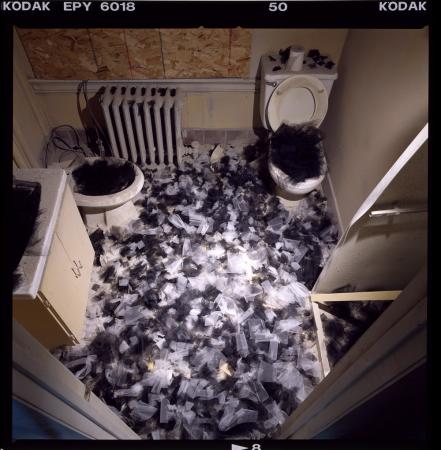
On 11 September 2001, the Spanish artist based in New York Elena del Rivero, was in Madrid preparing her forthcoming inauguration when she saw the Twin Towers collapse on the television. While she watched the clouds of dust, she imagined that her studio (located in 125, Cedar Street, just opposite the South Tower) had been destroyed and she also collapsed. She flew to New York and went directly to her creative space but the police wouldn’t let her through that day. Nor the next days, either. Sometime later, the residents of Ground Zero were allowed to return to their homes. Her studio was covered in dust and papers. She cleaned the dust and contamination produced by the attack from all the objects, and then she used a video camera to document the cleaning of the area and its everyday life. She recorded more than 100 hours of footage and she gathered together some 3,000 papers that she numbered, catalogued, photographed and sewed together with silk and pearls, materials that are characteristic of Elena’s work, who conceives sewing as drawing. One of the results of this process is the installation [Swi:t] Home: A Chant, 2001-06, which has been presented in such places as the New Museum of New York, and which she is now presenting, for the first time, together with the complete archive. In it, the pieces of destroyed paper represent an abstract emotion of suffering and the names of the people that were written on them have been burned, but even so, they bear witness to lives that were lost during the 9/11 attack, just like lives lost in any war.
El archivo del polvo (The Dust Archive) articulates a mise-en-scène that speaks of the effects of war, pollution, the cultivation of raw materials, migrations, the transformation of architecture to help displaced peoples, the pain of loss… A material that has inspired the participation of artists at Naves Matadero – International Living Arts Centre such as choreographer, dancer, painter and poet Mónica Valenciano based on Elena del Rivero’s project, generating new materials of thought and performance art. On 13 November, Valenciano will inaugurate El archivo del polvo with a piece designed specifically for the occasion. El archivo del polvo helps us to understand the importance of the ephemeral, the (non)physical, the (im)material, the absence, the void, the voice and the words, the gesture and the movement that accompanies each spectator as the fundamental protagonist of a choreographic evolution in relation to the exhibited work.
There is a parallel between the work that Elena del Rivero has produced in the aftermath of the 9/11 disasters and Goya’s Disasters. Both were direct agents and are connected through the expression “Yo Lo Vi” (“I Saw It”) which is the title of Goya’s Disaster 44. This is no random comparison. Goya used this phrase to describe his own experience – he witnessed the mass exoduses of the Spaniards in the face of the advance of the French troops. It is a reflection of the history of social, human and cultural events; something that underpins Elena del Rivero’s work in El archivo del polvo. In addition, some of the images taken by Elena del Rivero in her New York studio can be seen in the streets of different neighbourhoods of Madrid. And the house on the roof of Nave 10 will be the setting for a video installation also created by the artist. (Matadero press-release)
Nota: “Esta instalación contiene imágenes que pueden herir la sensibilidad del espectador”.
quepintamosenelmundo, art, visual arts, spanish art, art online, contemporary art
Matadero. Nave 11. Sala Fernando Arrabal, Paseo de la Chopera, 14. 28045 Madrid
https://naves.mataderomadrid.org
Image: Elena del Rivero “el archivo del polvo”
